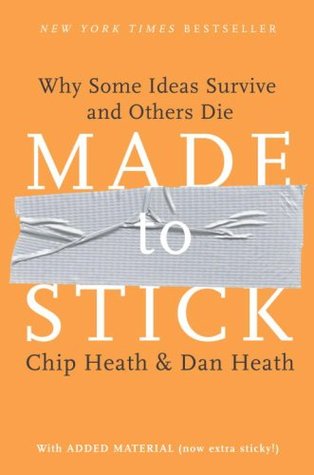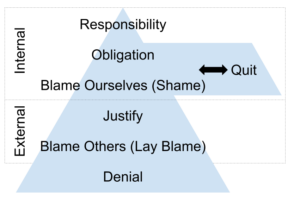 Difficult Conversations: How to Discuss What Matters Most by Douglas Stone, Bruce Patton & Sheila Heen
Difficult Conversations: How to Discuss What Matters Most by Douglas Stone, Bruce Patton & Sheila Heen
My rating: 4 of 5 stars
When we talk there are three different conversations actually taking place at the same time. The “What happened” conversation, the feeling conversation and the identity conversation.
The “What happened” conversation
When we have difficult conversations we tend to focus on the “What happened” conversation which itself is split down into three parts – who’s right, who meant what and who’s to blame.
The truth assumption – When starting the conversation we start from the place of “I am right and you are wrong”, from which all of the problems flow. The problem is difficult conversations are never about getting the facts right – they are about conflicting perceptions, interpretations and values. Conversations are not about what is true, they are about what is important.
The intention invention – we assume we know the intentions of other people, but in fact we don’t. When we are unsure about their intentions we naturally assume they are bad selfish etc.
The blame frame – this only produces disagreement, denial and little learning evoking fear and punishment so our energy goes into defending ourselves.

We take the data to form observations which then form interpretations which finally form conclusions – which are now quite abstract from the original data. Additionally this is different for each person – each have different data based on different viewpoints, these plus our own knowledge and experience with each person knowing themselves vastly better than others resulting in different observations, interpretations and conclusions usually reflecting self interests. To move forward you have to try to understand their perspective. Don’t present your conclusions as The Truth, share where your conclusions come from, don’t exaggerate with “always” and “never” give them room.
Disentangle intent from impact, people feel that someone has (e.g.) hurt them intentionally where as in reality the intent could have been quite different. Disentangling these is a challenge as people easily see and feel the impact and assume that is what the intent was – which can be far from the case. Take this as a hypothesis and enquire as to the impact which the original person intended. Be open to reflecting on the complexity of your intentions.
Quit backwards looking blame and instead look at contribution so that you can learn from this. “How did we each contribute to this situation?” knowing this then we can ask “How can we change this?”. The key is contribution is joint, each contributed to the result and understanding is key to learning. Remember to focus on all parties contributions, understand feelings and this is not about blaming the victim but understanding “What did I do to contribute to the situation?”. There are four hard to spot contributors – avoiding a problem till now, being unapproachable, relationship interactions with reinforcing cycles and problematic role assumptions. Try out two approaches – role reversal and the perspective as an observer.
| Truth | → | Different stories |
| Accusations | → | Intention and impact |
| Blame | → | Contribution |
| Judgements, characterizations | → | Feelings |
| What’s wrong with you | → | What’s going on for them |
The Feelings conversation
Difficult conversations are inherently about feelings and are an integral part of the conflict. Without discussing feelings you are not actually discussing the actual issue (in most cases) so putting these on the table for discussion is key to resolve some problems.
Sharing feelings without evaluation. Acknowledge how people feel so that they feel heard and respected. Sometimes feelings are all that matter.
The Identity conversation
How does what happened affect my self esteem, my self image, my sense of who I am in the world? This is what am I saying to myself about me.
Ground yourself – ask what is at stake when there is an identity threat. Identity threats look at “Am I Competent?”, “Am I a good person?” and “Am I worthy of love?”. People tend to feel it is all or nothing where in fact it is all grey. You need to accept that you will make mistakes, your intentions are complex and you have contributed to the problem. Take a longer term perspective which likely will reduce the impact of this issue. Raise identity issues explicitly.
Use curiosity – but with safety not to answer. Check your understanding and show that you are listening perhaps by paraphrasing back. Invite them as partners in sorting out the situation together.
- Can you say a little more about how you see things?
- What information might you have that I don’t?
- How do you see it differently?
- What impact have my actions had on you?
- Can you say a little more why you think this is my fault?
- Were you reacting to something I did?
- How are you feeling about all of this?
- Say more why this is important to you?
- What would it mean to you if that happened?
 Switch: How to Change Things When Change Is Hard
Switch: How to Change Things When Change Is Hard Decisive: How to Make Better Choices in Life and Work
Decisive: How to Make Better Choices in Life and Work Made to Stick: Why Some Ideas Survive and Others Die
Made to Stick: Why Some Ideas Survive and Others Die The Responsibility Process: Unlocking Your Natural Ability to Live and Lead with Power
The Responsibility Process: Unlocking Your Natural Ability to Live and Lead with Power
 Sprint: How to Solve Big Problems and Test New Ideas in Just Five Days
Sprint: How to Solve Big Problems and Test New Ideas in Just Five Days When: The Scientific Secrets of Perfect Timing
When: The Scientific Secrets of Perfect Timing